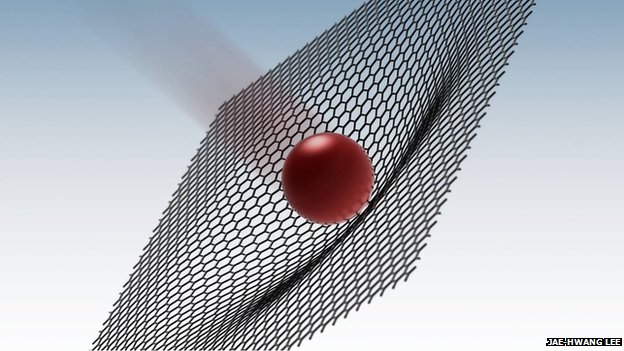Researchers at University of Massachusetts-Amherst have demonstrated that ‘wonder material’ graphene can be employed to better our existing bulletproof armor range as it is better able to withstand the impact of bullet as compared to steel or Kevlar (material currently used in bulletproof vests). In fact, it withstands the impact of a high-speed projectile ten times as well as steel and twice as well as Kevlar. The scientists set up a miniature firing range in their lab to analyse the strength of graphene sheets.

The tests involved vaporizing gold filaments, which in turn fired silicon sphere micro-bullets at graphene sheets between 10 and 100 layers thick at the speed of 3000 meters/second. It was then observed that graphene absorbed the immense amount of kinetic energy, stretching backwards and deforming into a conical shape at the point of impact and then cracked out radially into a pattern that moved several directions. However, the manner in which the graphene sheets responded to the bullet, allowing for a wider impact hole could prove to be a major disadvantage. The researchers maintained that blending graphene with one of the composites could prevent the crack solve the issue. The observations were made via an electron microscope.
Graphene body armor could be a reality, but it will be quite an expensive one at that. But the cost is nothing compared to the lives it’ll save.
Source : BBC
Researchers at University of Massachusetts-Amherst have demonstrated that ‘wonder material’ graphene can be employed to better our existing bulletproof armor range as it is better able to withstand the impact of bullet as compared to steel or Kevlar (material currently used in bulletproof vests). In fact, it withstands the impact of a high-speed projectile ten times as well as steel and twice as well as Kevlar. The scientists set up a miniature firing range in their lab to analyse the strength of graphene sheets.
The tests involved vaporizing gold filaments, which in turn fired silicon sphere micro-bullets at graphene sheets between 10 and 100 layers thick at the speed of 3000 meters/second. It was then observed that graphene absorbed the immense amount of kinetic energy, stretching backwards and deforming into a conical shape at the point of impact and then cracked out radially into a pattern that moved several directions. However, the manner in which the graphene sheets responded to the bullet, allowing for a wider impact hole could prove to be a major disadvantage. The researchers maintained that blending graphene with one of the composites could prevent the crack solve the issue. The observations were made via an electron microscope.
Graphene body armor could be a reality, but it will be quite an expensive one at that. But the cost is nothing compared to the lives it’ll save.
Source : BBC